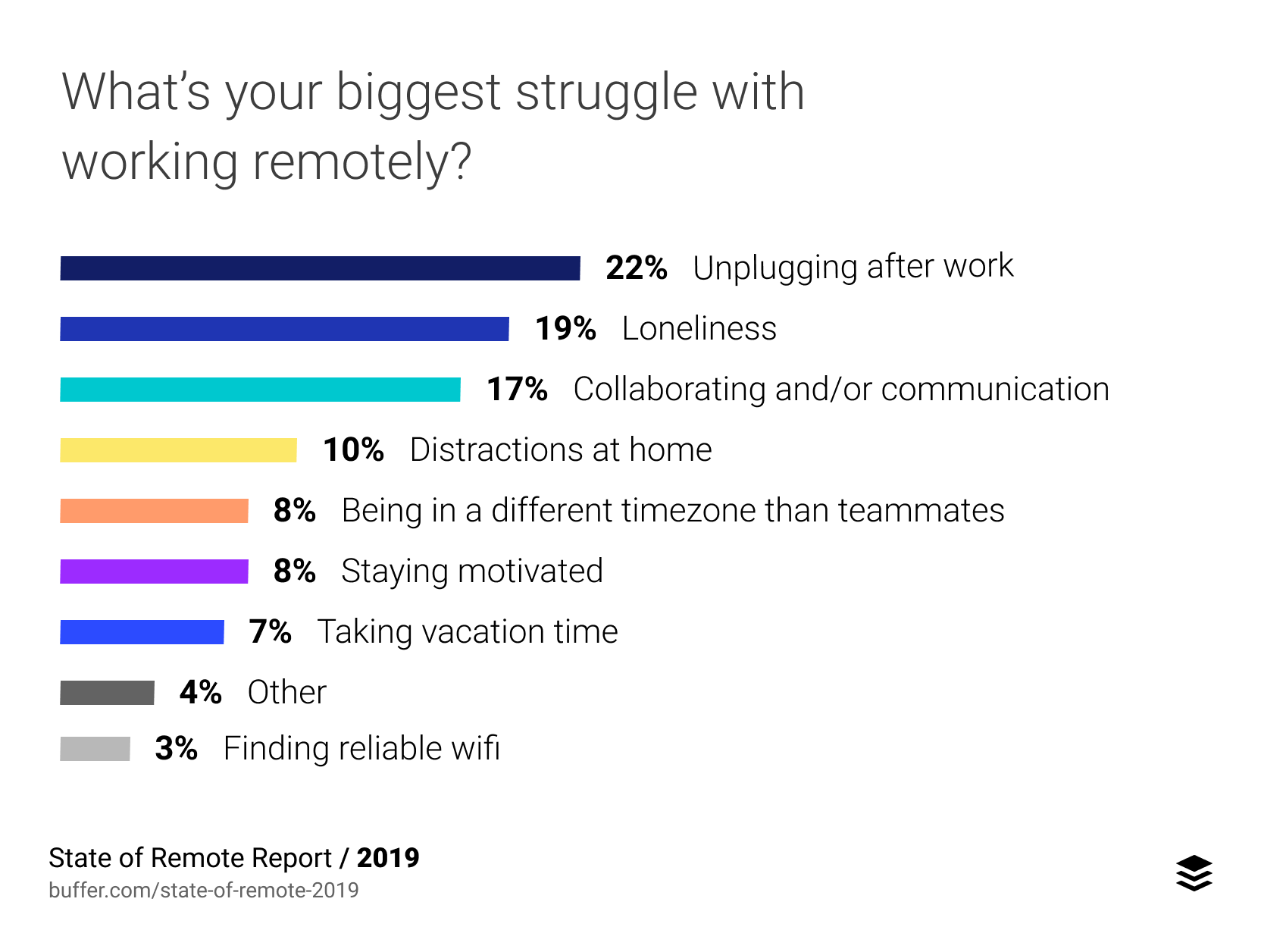What are the differences between working from home versus working in an office? Let’s compare them side-by-side to help you understand the unique advantages and disadvantages of each. Working From Home and Working in an Office.
Untersuchungen von Owl Labs legen nahe, dass ungefähr die Hälfte der Mitarbeiter in der Regel mindestens einmal pro Woche von zu Hause aus arbeitet und ein Drittel Vollzeitjobs in Vollzeit arbeitet.
Viele Organisationen haben ihre Werkzeuge verschoben und Systeme für entfernte Teams zum ersten Mal aufgrund der COVID-19-Pandemie. Für Arbeitnehmer und Arbeitgeber ist dies eine wesentliche Anpassung.
Pendeln
The average American worker spends at least 27 minutes on their daily commute to work, and it is getting worse. More than 14 million people spend an hour or more traveling to work,” according to NPR.
That’s a lot of time you can save by becoming a telecommuter! Telecommuting is another way to say working remotely or from home by making full use of the internet, email, and Telefon.
Einige Leute genießen es jedoch, früh aufzustehen, sich fertig zu machen und die Trennung von Zuhause und Büro zu haben. Aus diesem Grund entscheiden sich viele Leute, die remote arbeiten, immer noch dafür, in ein Café oder einen Coworking Space zu gehen.
The bottom line is people hate commuting. Work-life balance continues to surge on the importance meter for modern-day employees. Companies that don’t recognize this are missing a huge opportunity to adopt Strategien für die Arbeit von zu Hause aus das kommt ihrer Belegschaft zugute.
A poll posted by CEO of Product Hunt, Ryan Hoover, suggests that most people would take a pay cut if it gave them the ability to work remotely. Perks like infinite vacation time, free food, and 401k weren’t as important when compared to the benefits of working remotely.
Nehmen wir an, Sie suchen einen neuen Job. Was ist Ihnen am wichtigsten? 🤔
- Ryan Hoover (@rrhoover) 14. September 2018
Kommunikation
Nach Recherchen aus unserer Bericht über den Stand der Geschäftskommunikation 2020Die persönliche Kommunikation ist die von den Mitarbeitern am meisten bevorzugte Kommunikationsmethode.
Not counting video conferencing, face-to-face communication is something you really only get in an office space. It’s not only beneficial when planning for business, but it strengthens relationships and rapport with other employees. There’s something about relationship-building that happens when you sit next to someone or bump into each other at the coffee machine.
Communication still happens when you’re working remotely — it’s just different. Face-to-face communication turns into video calls. Short conversations turn into Slack messages. Emails … well, those stay emails. Nobody escapes those!
One compelling advantage of working from home is the ability to work anywhere. You don’t even need a laptop. With a full-featured Geschäftstelefon-AppMitarbeiter können mit ihrem iPhone oder Android Anrufe tätigen und empfangen, an Telefonkonferenzen teilnehmen, Kollegen benachrichtigen und online bleiben.
To improve communication for remote employees, we’ve seen many organizations require video conferencing over traditional phone calls when communicating with coworkers. Teams should have conference calls to align themselves with business goals. For fun, employees can even host online game nights to get to know each other outside of office life.
Einige Teams verlassen sich sogar auf soziale Medien für die Kommunikation. Zum Beispiel sagt Close.com, dass sie Verwenden Sie Snapchat intern for team building. It’s a cool and clever way to use social media to stay connected while working remotely.
Flexibilität
When working from an office, it’s likely you have a set schedule. Your alarm goes off at the same time every day, you grab your morning coffee at 7:05 am, and you’re at your desk by 9 am ready to work.
When it comes to working from home, it’s a little different. You now have the flexibility to wake up when you choose and tailor your day to your needs. If your company is new to remote work, chances are they still want all employees working the traditional work hours of 9-to-5. With remote work, you can now wake up (a little) later, pick a time for lunch, and close your laptop when you want — for some, that’s 4 pm, others it could be 7 pm.
As more companies adopt a remote-first policy, working hours will shift to fit the employee’s schedule. This shift means more flexibility on when you start and end your day and where you work from. You should be able to work from anywhere that has a solid internet connection!

Many employees struggle to disconnect when working from home. Up to a third of employees say they struggle to balance work and home life when working remotely. It’s easy to shut down your computer when you see fellow office workers start to pack up for the night, but when you’re at home, those cues don’t exist.
The option to freelance and take on side projects is another massive benefit that comes with working from home. The time you waste on commuting could be put toward taking on side projects or freelancing. It’s far more lucrative than sitting through traffic jams!
Büroumgebung vs. Häusliche Umgebung
Arbeiten Sie in einer Kabine? Ein offener Büroplan?
When working at the office, you don’t have a choice in your work environment or office setting. You might have a noisy coworker, or sit under the air conditioner, which could impact your productivity.
Wenn Sie von zu Hause aus arbeiten, kann jeder sein optimales Home Office oder seine optimale Workstation einrichten.
Sie können einen Stehpult gegenüber einem Sitzpult auswählen und eine Auswahl an Büromöbeln auswählen. Wenn Sie von zu Hause aus arbeiten, können Sie Ihre optimale Arbeitsumgebung verstehen, unabhängig davon, um welche es sich handelt.
Finanzielle Kosten
The differences from working from home versus working at an office can be seen when it comes to finances — and we’re not talking about how much money you earn.
When working at an office, you pay for the costs of commuting, such as public transit, gas, or maintenance expenses. If you’re driving, you might also have to pay for parking. You likely also pick up a coffee or buy lunch during the day. All of these expenses add up.
When you work from home, there are tons of financial perks. You don’t have to worry about sitting in traffic, commuting expenses, and you won’t be tempted to go out after work and spend money on happy hours and eating out.
Working from home has its own costs. In addition to broadband internet costs, employees need to think about their energy costs like electricity. They may also carry “startup” costs for Telearbeitstechnologie in der Regel von Arbeitgebern belastet. Typische Ausgaben für die Arbeit zu Hause sind Schreibtische, Stühle, Netzwerkrouter und Monitore.
Während Sie in gewisser Weise sparen, gibt es andere Arten von Kosten, die Sie durchdenken müssen.
Produktivität
Eine von UC Irvine durchgeführte Studie ergab, dass es sich um einen typischen Büroangestellten handelt unterbrochen every 11 minutes. If that wasn’t bad enough, it takes 25 minutes to get back on task. Yikes.
That’s a big hit to employee productivity. The nature of working remotely doesn’t make it inviting to chat with coworkers. Needless to say, productivity can get a huge uptick with remote workers. For example, call center employees that work from home were able to boost their productivity by 13%, according to a Stanford study. Consistent research has shown that remote workers log longer hours than their office-bound counterparts.
Studies show that it’s clear there is increased productivity in working at home versus working in an office. However, there can be a learning curve on how to increase your productivity and reduce Ablenkungen zu Hause.
Verwaltung
Many organizations have had to switch to remote work for the very first time. Managers are likely concerned because they’ve never had to Remote-Belegschaft verwalten.
Wenn Manager von einem Büro aus arbeiten, haben sie eine klare Vorstellung davon, woran die Teammitglieder arbeiten. Sie können Fragen stellen, täglich einchecken und Whiteboarding-Meetings abhalten, um sicherzustellen, dass alles auf dem richtigen Weg ist.
That’s not the case when it comes to working remotely.
Aus diesem Grund ist es für den Erfolg der Remote-Arbeit entscheidend, über die richtigen Tools zu verfügen. Wir nutzen eine Kombination aus großartiger Führung und leistungsstarken Tools wie Asana, um große Projekte auszuschalten.
Als Manager haben Sie möglicherweise den Wunsch, Mitarbeiter im Mikromanagement zu verwalten, wenn sie remote arbeiten. Stattdessen empfehlen wir, den Menschen zu vertrauen, bis sie das Gegenteil beweisen. Angestellte wollen to do well; it’s your job to help them get there.
Es wird immer Unterschiede geben, wenn man von zu Hause aus arbeitet. Remote arbeiten
Some call these differences advantages versus disadvantages — we call them opportunities. The team at Nextiva works remotely, and we’ve realized even more notable productivity gains from our Cloud-Telefonsystem to accelerate the shift from the office to work from home.
Da viele Unternehmen den Sprung machen, werden sie bald feststellen, dass eine entfernte Belegschaft können ein kluger, strategischer Schritt sein. Um alle Vorteile nutzen zu können, müssen Arbeitgeber (und Arbeitnehmer gleichermaßen) absichtlich mit ihnen umgehen Unternehmenskommunikation.



